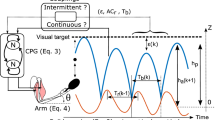Abstract.
To uncover the underlying control structure of three-ball cascade juggling, we studied its spatiotemporal properties in detail. Juggling patterns, performed at fast and preferred speeds, were recorded in the frontal plane and subsequently analyzed using principal component analysis and serial correlation techniques. As was expected on theoretical grounds, the principal component analysis revealed that maximally four instead of the original six dimensions (3 balls × 2 planar coordinates) are sufficient for describing the juggling dynamics. Juggling speed was shown to affect the number of dimensions (four for the fast condition, two for the preferred condition) as well as the smoothness of the time evolution of the eigenvectors of the principal component analysis, particularly around the catches. Contrary to the throws and the zeniths, and regardless of juggling speed, consecutive catches of the same hand showed a markedly negative lag-one serial correlation, suggesting that the catches are timed so as to preserve the temporal integrity of the juggling act.
Similar content being viewed by others
Author information
Authors and Affiliations
Additional information
Received: 1 April 1999 / Accepted in revised form: 9 August 1999
Rights and permissions
About this article
Cite this article
Post, A., Daffertshofer, A. & Beek, P. Principal components in three-ball cascade juggling. Biol Cybern 82, 143–152 (2000). https://doi.org/10.1007/PL00007966
Issue Date:
DOI: https://doi.org/10.1007/PL00007966




